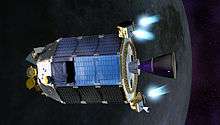Zond 7
|
Zond 7 | |
| Names | Soyuz 7K-L1 s/n 11 |
|---|---|
| Mission type | Spacecraft test |
| Operator | Soviet Union |
| COSPAR ID | 1969-067A |
| SATCAT № | 4062 |
| Spacecraft properties | |
| Bus | Soyuz 7K-L1 |
| Manufacturer | OKB-1 |
| Launch mass | 5,979 kilograms (13,181 lb) |
| Start of mission | |
| Launch date | 23:48:06, August 7, 1969 |
| Rocket | Proton-K with Block D upper stage |
| Launch site | Baikonur Cosmodrome |
| End of mission | |
| Disposal | Soft landing and recovery |
| Recovered by | Soviet Union |
| Landing date | August 14, 1969 |
| Landing site | south of Kustanai |
| Flyby of Moon | |
| Closest approach | August 11, 1969 |
| Distance | 1,984.6 km (1,233.2 mi) |
Zond 7, a formal member of the Soviet Zond program and unmanned version of Soyuz 7K-L1 manned moon-flyby spacecraft, the only truly successful test of L1, was launched towards the Moon from a mother spacecraft (69-067B) on a mission of further studies of the Moon and circumlunar space, to obtain color photography of Earth and the Moon from varying distances, and to flight test the spacecraft systems. Earth photos were obtained on August 9, 1969. On August 11, 1969, the spacecraft flew past the Moon at a distance of 1984.6 km and conducted two picture taking sessions. Zond 7 reentered Earth's atmosphere on August 14, 1969, and achieved a soft landing in a preset region south of Kustanai, Kazakhstan.
Like other Zond circumlunar craft, Zond 7 used a relatively uncommon technique called skip reentry to shed velocity upon returning to Earth. Of all circumlunar Zond craft launches, Zond 7 would have been the first to make a safe flight for a crew had it been manned.
The return capsule is on display at Orevo, Russia.
Notes
- This article was originally based on material from NASA (NSSDC) information on Zond 7
External links
| Preceded by Zond 6 |
Zond program (circumlunar) | Succeeded by Zond 8 |



